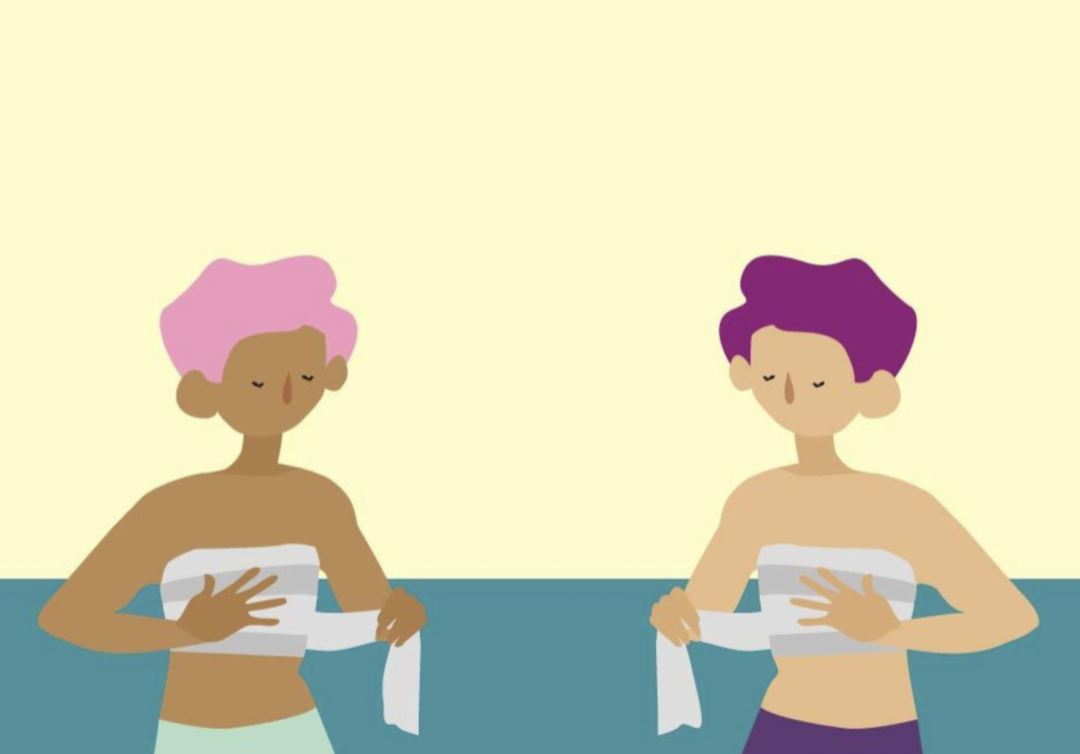By: Greer Taylor-Ginsberg
Today my daughter and I have taken our annual trip to the beach, a week before she’ll leave for her freshman year of college. I’m a bit teary watching her gingerly test the waves with her toes. Feeling sentimental as kids leave home isn’t unusual for moms, but today I’m fighting bigger demons too, the ones that have sold her a lie easily summed up by what she’s wearing: boys’ swim trunks and a swim tee-shirt over something I never knew existed: a breast binder– a tight-fitting lycra and nylon short undershirt designed to masculinize a female’s profile by mashing her breasts flat.
Yep. Flat.
If this is news to you (and especially if you’re female), you likely just winced imagining it. Proponents of binders claim they alleviate the emotional torment of gender dysphoria by helping her pass as male. Gender dysphoria is a condition wherein one’s gender identity does not feel aligned with her body. It’s a psychological disorder requiring nuanced treatment. The number of adolescents presenting with gender dysphoria has exploded worldwide in the last few years. In the UK, the increase has reached 4400%, leading responsible doctors and researchers to question social contagion.
My daughter informed us she was transgender three years ago at 16, with zero history of childhood gender nonconformity. Her private school affirmed her identity by assisting her in changing her name and pronouns on records, downplaying our concerns of underlying issues and how this move might perpetuate her beliefs. In the years prior to this, she was an accomplished ballet dancer, a creative fashionista, a kid who couldn’t wait for pierced ears and who called herself boy-crazy. She was an exceptional student with budding leadership skills and unique perspectives, according to her teachers. Friendships were hard, though, and she experienced trauma from ages 11-15 when her closest cousin developed a life-threatening health condition. In eighth and ninth grades, she began self-isolating, spending enormous numbers of hours online. She became depressed, lonely, and highly anxious. During this time of intense emotional vulnerability, she was seduced by the concept of transgenderism. Dissociation from self is a feature of PTSD, and the notion of becoming a new person free of pain and with stereotypical male toughness fit into her psychological needs perfectly.
Since 16, her clothing choices have become increasingly masculine, her haircuts shorter. She’s cried to me that she hates her breasts and needs the binder to leave the house. The binder, a tangible accessory to her male identity, is a maladaptive coping mechanism she uses like a turtle shell to keep herself safe. I don’t know to this day who paid for it. Maybe she got it from Point of Pride, a nonprofit that sends free binders to anyone who identifies as trans (female to male) in financial need, without any minimum age requirement. Or GC2B, an online binder retailer whose founder reported the company experienced “at least 200% growth” between 2015-2019. I am not in the business of denying adults binders if they understand the documented health risks, but when the name of the company is GC2B— widely assumed, according to Reddit (and uncontested by the company), to stand for “girls change to boys”— it sure seems like an invitation to the <18 crowd. And neurologically speaking, the human brain isn’t fully developed until age 25. There’s not enough research on how binding impacts healthy breast tissue during adolescence, but common sense suggests not well. All the binder retailers I found have wearing guides, cautioning customers to limit binding to eight hours a day (similar to a school day) and to switch to sport bras during exercise. Reported medical problems associated with binders are shortness of breath (check), dizziness/lightheadedness (yep), back and chest pain (umhmm), and even cracked ribs. What I notice is an increased insecurity in her natal self.
Besides the problematic ethics in marketing binders to kids, there is evidence that children who socially transition (change their names and pronouns, clothing and hairstyles to match stereotypical gender norms of the opposite sex) are more likely to seek medical transition down the road. That means that once kids get it into their heads that girls can change to boys (which is scientifically impossible even with transition surgery), they move deeper into their dysphoria, on the train to irreversible effects from testosterone treatment. Next stop, needless surgeries and ultimately, becoming a lifelong medical patient who will likely still suffer with dysphoria. In a complete perversion of language, proponents promise the binder will liberate its wearer to “live his truth”. How is persuading a female she’s entrapped in her healthy body by telling her it needs fixing progressive in any way? What freedom is this?
My daughter’s already fragile mental health spiraled downward rapidly since the social transition. The cheerleaders at school are long gone, far more enthralled with the idea of a unicorn in their midst than in caring about her well-being or truly including her. The pro-LGBTQ initiative, when it came to the T, was a superficial, misguided crock of manure mixed with virtue signaling. The medical community was worse, dismissing our concerns and any meaningful probing of her myriad issues while pointing us toward the gender clinic.
So that binder? It was my daughter’s gateway drug into dysphoria, a symptom of something much bigger than the garment itself. We are living in a time where celebrating diversity has lost its meaning and is being mass merchandised at the expense of impressionable young people. The profit incentives are massive for pharmaceutical companies, plastic surgeons, endocrinologists, and cottage industries like those selling “gender affirming underwear”.
Today at the beach, I breathe uneasily, watching my daughter furtively glance over her shoulder, checking to see who might be judging her. Just a few years ago she would have been in a bikini. A few years before that, she would have been completely oblivious to onlookers, in that carefree way children can be. Suddenly, she dives under the waves, disappears, and pops back up. Momentarily invigorated by the icy water, her face is bright, her smile effervescent. “It’s freezing!” she calls.
There’s my girl, I think, waving. I’ll fight for her to the end.
Originally published at https://pitt.substack.com/p/breast-binders-a-gateway-drug reproduced by kind permission.

